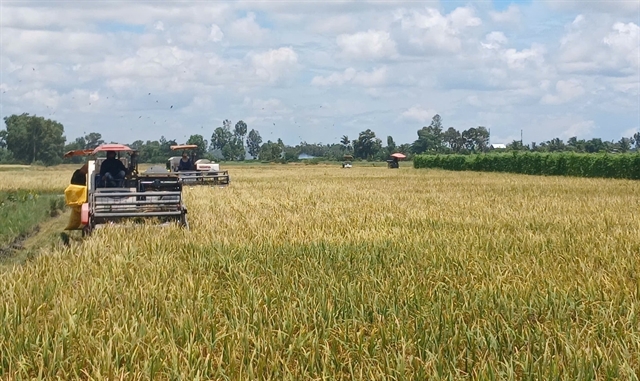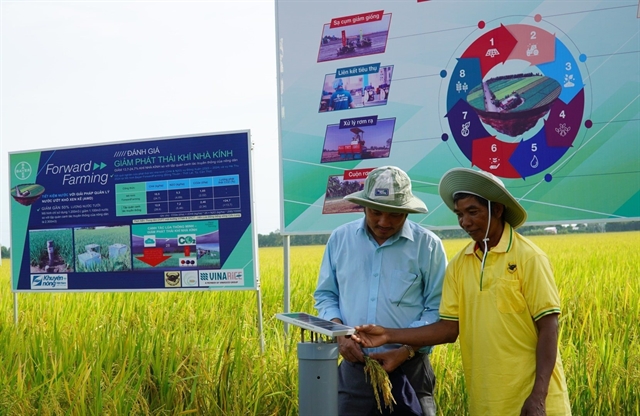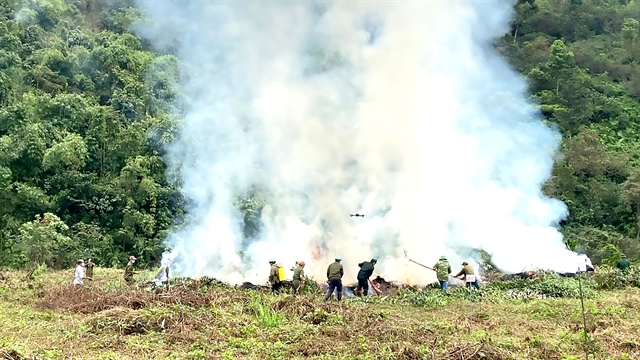 Economy
Economy


|
| Mechanised harvesting at the high-quality and low-emission rice cultivation model of the Hồng Phát Agricultural Service Cooperative in Cà Mau Province. — VNA/VNS Photo |
HÀ NỘI — The collective label “Low-Emission Green Vietnamese Rice”, developed by the Vietnam Rice Sector Association (VIETRISA), is gaining strong market traction, reinforcing the image of Vietnamese rice as environmentally friendly and aligned with sustainable development.
A milestone
In early June, the first batch of rice bearing the “Low-Emission Green Vietnamese Rice” label departed Cần Thơ Port for Japan – one of the world’s most demanding markets. The shipment not only marked a new export order but also a significant milestone in the sector’s shift from traditional cultivation to sustainable, low-emission, higher value-added production.
The VIETRISA, in partnership with Trung An Company, held a ceremony to export the first shipment – the first product under the programme to develop one million hectares of high-quality, low-emission rice cultivation associated with green growth in the Mekong Delta to 2030 (the One Million Hectare Programme)
The “Low-Emission Green Vietnamese Rice” label is granted by the VIETRISA to rice produced in accordance with the One Million Hectare Programme’s technical standards, verified by commune authorities or accredited international organisations. Certified products must ensure clear traceability, covering production area, variety and cropping season, and full compliance with low-emission, high-quality cultivation protocols.
With support from the Netherlands Development Organisation, VIETRISA has so far issued label-use certificates to seven enterprises, representing more than 19,200 tonnes of rice.
The introduction of tens of thousands of tonnes of rice under this label, including the first shipment to Japan, confirms Việt Nam as the first country in the world to place low-emission rice on both domestic and export markets.
To date, around 20,000 tonnes of rice have been certified under the label, including 500 tonnes shipped to Japan, a market with stringent food-safety requirements. While price differentiation is still developing, the label significantly enhances credibility, environmental value and market positioning, highlighting Việt nam’s determination to green its rice sector.
A strict and transparent certification process

|
| Farmers in An Giang Province test a water-saving irrigation sensor station within the model of “low-emission rice cultivation for sustainable development of material rice farming areas for export in the Mekong Delta”. — VNA/VNS Photo |
To obtain the “Low-Emission Green Vietnamese Rice” label, enterprises or cooperatives must operate within designated production zones of the One Million Hectare Programme, obtain local government confirmation and register before seeding. The cultivation process must follow the Ministry of Agriculture and Environment’s low-emission technical standards and undergo on-site verification.
Currently, VIETRISA is completing procedures to register the label with the Intellectual Property Office and is working with international certifying bodies to evaluate and validate products under recognised low-emission standards, laying the foundation for global protection and recognition.
According to Lê Thanh Tùng, secretary-general of VIETRISA, the One Million Hectare Programme has attracted unprecedented engagement from across the sector, from farmers, cooperatives, enterprises, research institutions to local authorities. Beyond technical and economic benefits, the programme carries significant socio-economic and political value, supporting Việt Nam’s commitment to achieving net-zero emissions by 2050.
From 2025, the programme will expand production to build a comprehensive, sustainable rice ecosystem. High-quality, low-emission rice areas will continue to grow, paving the way for a national certification label and, ultimately, a national brand for Low-Carbon Vietnamese Rice, promoting the sector’s growth and enhancing the global reputation of Vietnamese rice.
Building on the success of the “Low-Emission Green Vietnamese Rice” label, Việt Nam is moving towards establishing a national brand – “Low-Carbon Vietnamese Rice” – further cementing its place on the global agricultural map.
From the first 500 tonnes of “green” rice to the expanding low-carbon fields of the Mekong Delta, Việt Nam is demonstrating its resolve to elevate its longstanding rice sector within the global value chain. “Vietnamese Green Rice” represents not only sustainable agriculture but also the country’s broader ambition to green its economy and secure a prosperous, resilient future for Vietnamese farmers. — VNA/VNS




